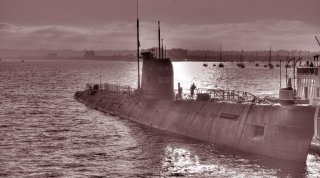One Man Stopped the Cuban Missile Crisis From Destroying Everything
The world bears a debt of gratitude for his stubborn refusal to succumb to baser instincts.
Here's What You Need To Remember: Arkhipov retained his presence of mind in the direst circumstances and refused to follow his colleagues into delirious martyrdom.
The Cuban Missile Crisis is most commonly conveyed as the story of U.S.-Soviet diplomatic and military posturing that brought the world to the brink of nuclear annihilation over a thirteen-day span in October 1962. But even as President John F. Kennedy and Soviet Premier Nikita Khruschev raced to avert the abyss of destruction in a series of hurried of negotiations, a Soviet submarine off Florida’s coast came within a hair's breadth of plunging the world into a nuclear catastrophe-- but for the actions of a lone Soviet navy officer.
In early 1962, the Soviet security establishment devised a daring plan to counter the first-strike threat posed by the presence of U.S. Jupiter Medium-range ballistic missiles (MRBM) in Turkey. Operation Anadyr, colorfully described by Khruschev as “putting one of our hedgehogs down the Americans’ trousers,” entailed the transfer and deployment of three nuclear-capable R-12 MRBM and two R-14 intermediate-range ballistic missile (ICBM) battalions, among numerous other types of weapons ranging from tank divisions to missile boats, to Fidel Castro’s Cuba.
Operation Anadyr was, down to the name itself, designed around a series of clever diplomatic, military, and logistical ruses that successfully concealed the cross-continental movement of tons of Soviet military hardware in Washington’s backyard. Once in Cuba, however, the nuclear missile installations were quickly discovered and extensively photographed by U-2 and F-8 surveillance planes; the crisis began in earnest on October 22, when President Kennedy moved to impose a blockade, which he called a “quarantine” for diplomatic expediency, on Cuba.
The blockade created a steel ring around four diesel-electric Foxtrot-class submarines-- the B-4, B-36, B-130, and B-59, each armed with one nuclear-capable T-5 torpedo and boasting a total capacity of 22 torpedoes spread across 10 tubes. These vessels were dispatched to the Cuban port of Mariel at the beginning of October, to provide the Castro regime with a nuclear-armed missile submarine deterrent against a prospective US invasion.
All four vessels were detected, partly as a result of numerous malfunctions sustained from being ordered to travel to Cuba at a breakneck speed of 10 knots, and partly due to ill-advised radio communication practices. The anti-submarine warfare (ASW) forces of the U.S. Navy set out to hunt the four Soviet submarines, unaware that they could be carrying nuclear payloads. The ASW was under strict orders not to use anything other than practice depth charges (PDC), low-powered explosive devices meant to signal to hostile submarine operators that they had been spotted. Soviet high command was alerted to these signals, but subsequent research has shown that this knowledge never trickled down to the four Soviet submarine commanders; indeed, each one of the four captains perceived the PDC detonations as hostile military actions.
Despite the risks inherent in these methods, two of the four submarines were successfully forced to surface and left Cuban waters without a direct confrontation; another stayed submerged for long enough to lose the ASW patrol and return home. But the captain of the B-59, Valentin Savitsky, insisted on calling the ASW’s bluff, refusing to surface in spite of his ship’s depleted battery. After four days of nonstop PDC shelling, internal temperatures had shot up to intolerable levels and crew members were beginning to faint from oxygen deprivation.
Gripped by paranoia and cut off from Moscow, Captain Savitstky concluded that the war had already begun and that the only honorable way out was to fire the B-59’s nuclear warhead at their ASW pursuers: “We’re gonna blast them now! We will die, but we will sink them all – we will not become the shame of the fleet,” he exclaimed to his exhausted crew.
The B-52 was already cleared by Moscow to use any force that is deemed necessary, but protocol required all officers aboard the vessel to unanimously approve the decision to deploy nuclear warheads. The ship’s political officer, Ivan Maslennikov, gave his consent. This would normally have been all that’s required to initiate a chain of events likely culminating in a third world war. As it happens, there was a third officer aboard the B-59 on that fateful day: Vasili Arkhipov, second captain of the B-59 and commodore of the entire Cuban submarine flotilla. Witness accounts report that Arkhipov single-handedly stonewalled the nuclear torpedo launch, convincing Savitsky to surface and await further orders from Moscow.
The B-59 finally emerged, surrounded by U.S. warships and helicopters, flying the Soviet flag and demanding that the ASW patrol stop their “provocative actions.” The crew was gaunt and harried, but not defeated-- they could perhaps be forgiven for indulging in an obstinate pride, having persisted until the very last moment in the face of hellish living conditions and unrelenting military pressure.
Then there is Arkhipov, who retained his presence of mind in the direst circumstances and refused to follow his colleagues into delirious martyrdom. There is, admittedly, little comfort in the notion that one man’s chance intervention was all that stood in the way of a conflagration that could have spiraled into a global nuclear war. And yet, the world bears a debt of gratitude for his stubborn refusal to succumb to baser instincts; for looking into the abyss, and having the restraint to recoil at what he saw. In that sense, we could use more Arkhipovs.
Mark Episkopos is a frequent contributor to The National Interest and serves as research assistant at the Center for the National Interest. Mark is also a PhD student in History at American University. This first appeared in 2019. Image: Flickr

